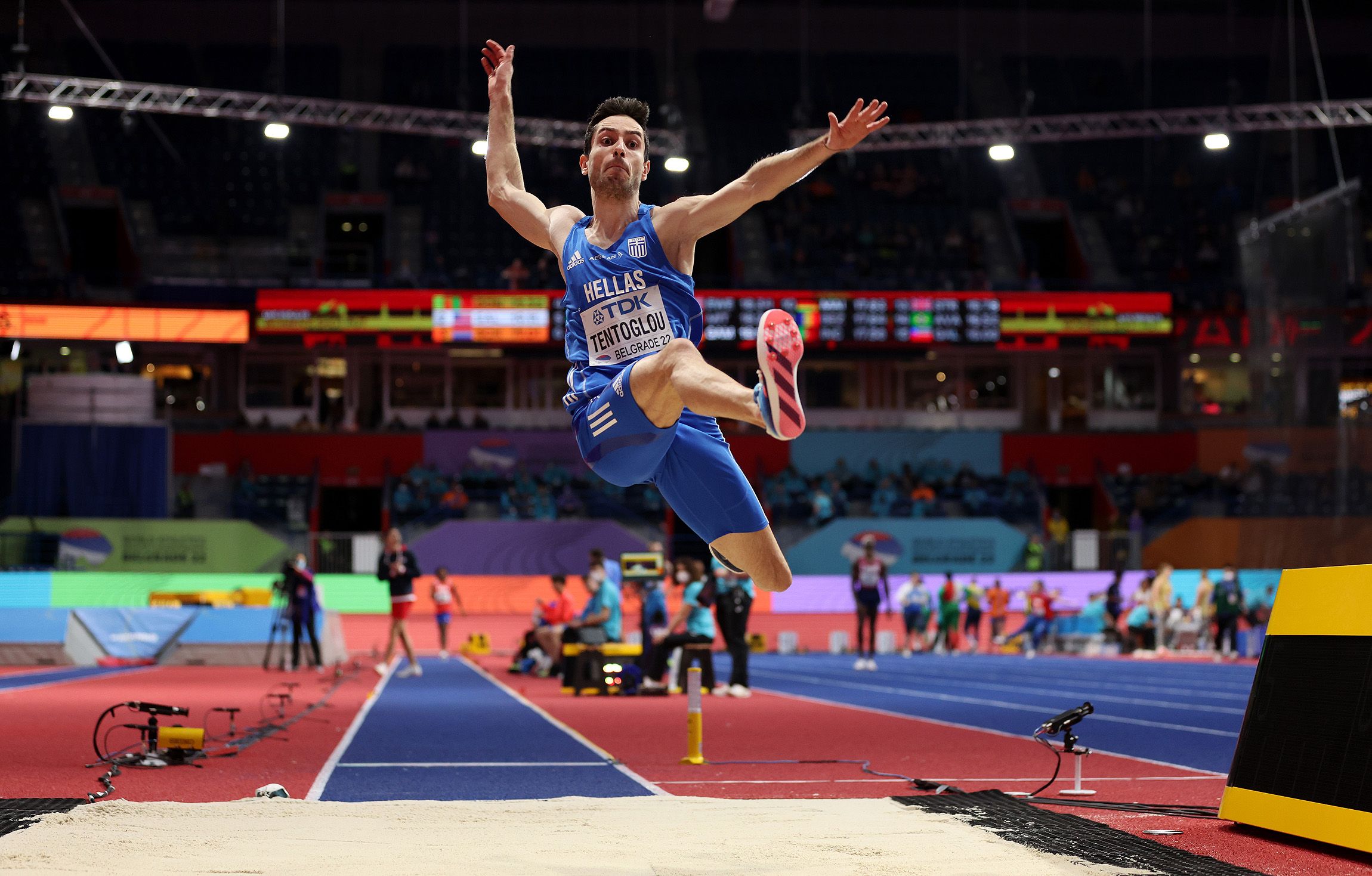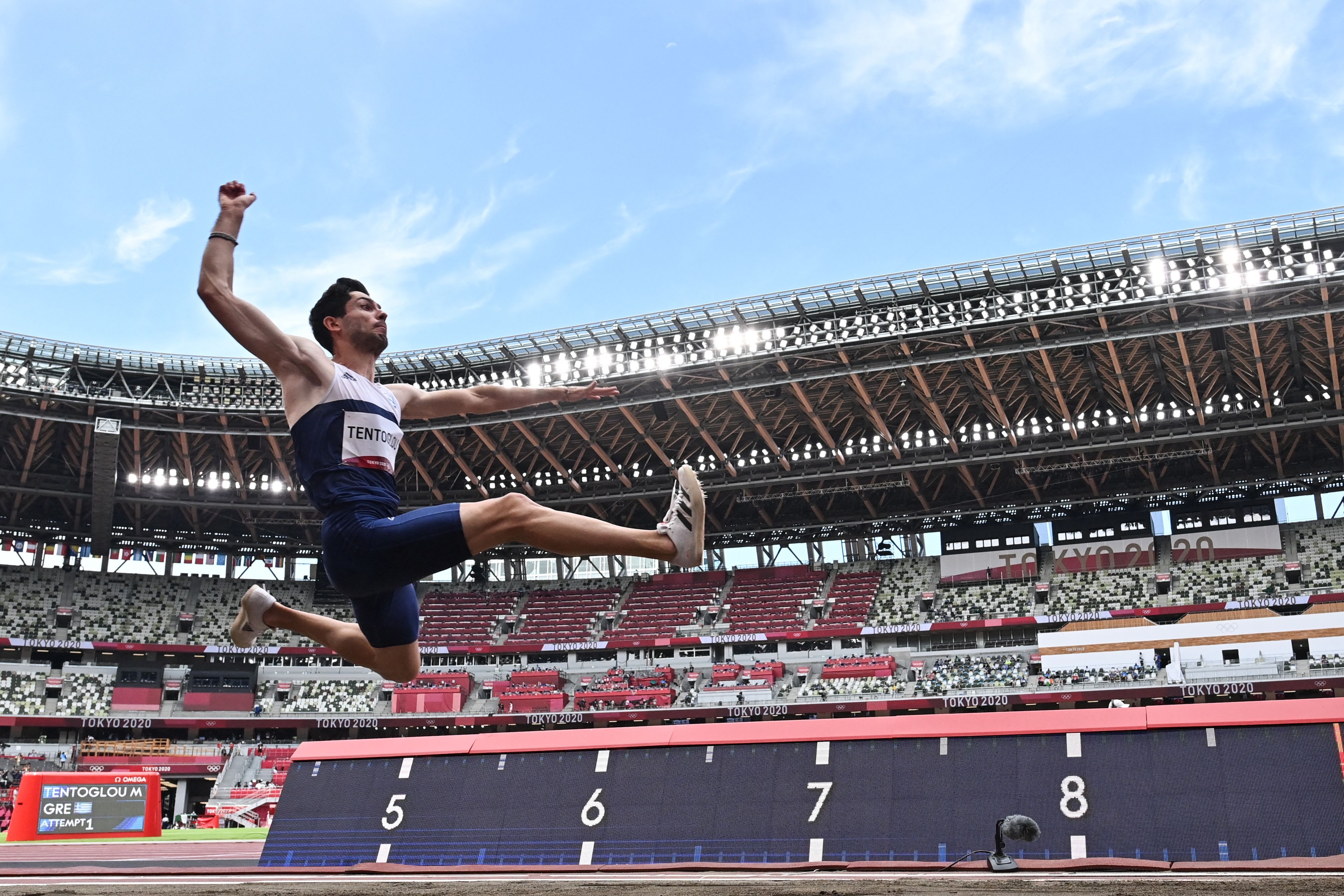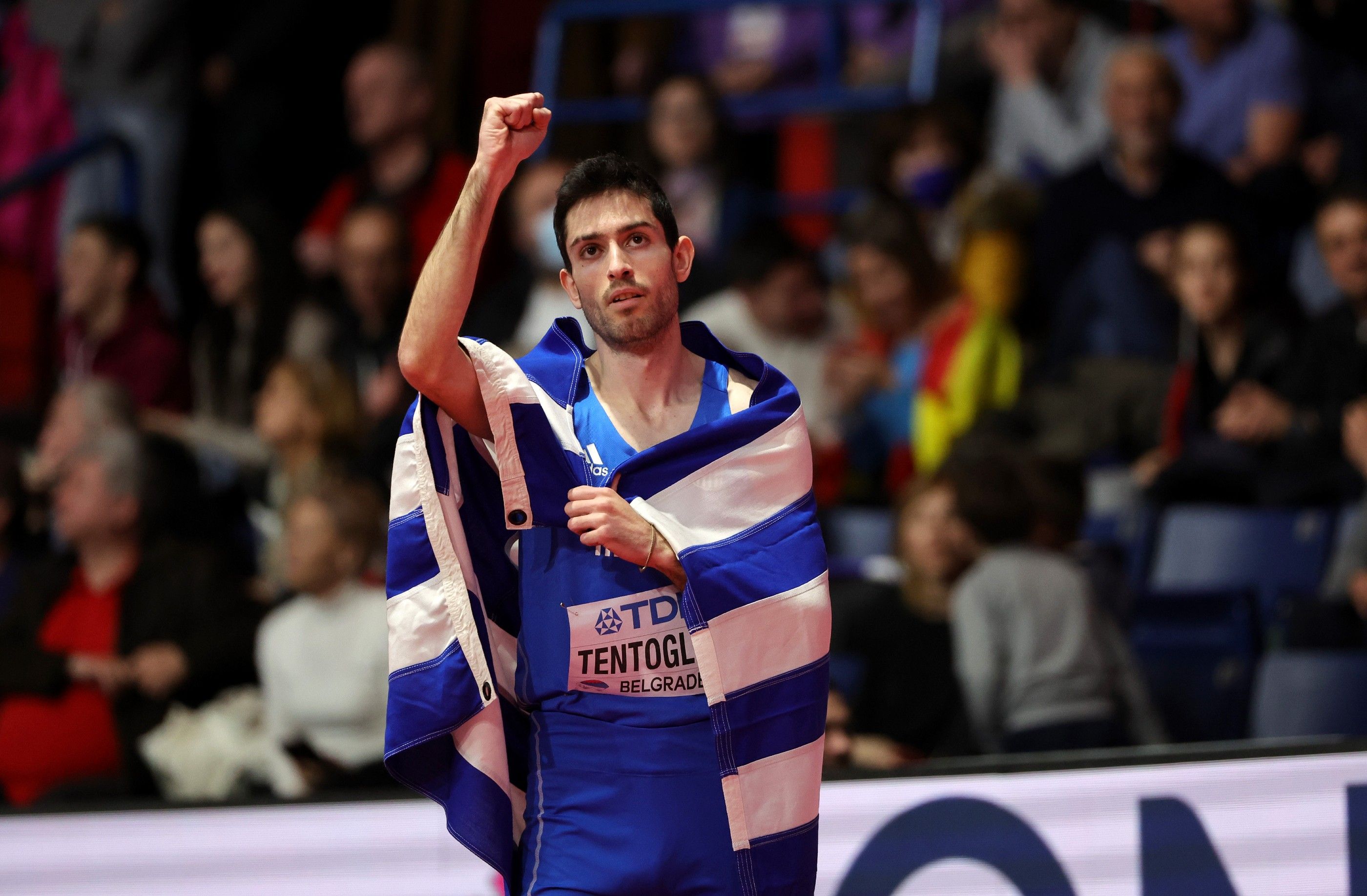World indoor long jump champion Miltiadis Tentoglou (© AFP / Getty Images)
The famed running coach Arthur Lydiard once said that there are “champions everywhere, every street’s got them – all we need to do is train them properly.”
Evangelos Papanikos knows the truth in that. In Grevena, a small town in northern Greece, he was coaching at the local athletics stadium many years ago when his eye was drawn to one of the teenagers doing parkour in the stands.
One kid was older, more athletic, than the others, displaying a blend of power, speed and gymnastic agility that Papanikos knew could be put to good use on a track, or indeed the field. He convinced the youngster to give athletics a go.
That kid was Miltiadis Tentoglou, and these days he’s the reigning Olympic champion in the long jump, the European champion and, on Friday (18), the day he turned 24, he added to his long list of achievements at the World Athletics Indoor Championships Belgrade 22.

Tentoglou soared to a Greek indoor record of 8.55m to win gold with ease, sending a message that his success in Tokyo last year was no fluke.
He’s at the top, and it looks like he’s here to stay.
“He is very easy to coach,” says Georgi Pomashki, who has coached him for the last five years, taking the baton from Papanikos when Tentoglou was in his late teens. “You don’t have to do an exercise 10 times to get him to perfect it. It’s difficult to find an athlete like that: it’s a present from God.”
When Pomashki took over, he could quickly see the benefit of Tentoglou’s parkour background.
“In parkour, everything has to be exact and he got this focus from this sport,” he says. “This has helped to make him exact in his movement.”
The sport involves moving between different points at speed, typically in an urban setting, without any assistance. It has its roots in military obstacle course training and martial arts, and requires an ability to run, climb, swing, vault, and, of course, to jump.
“It makes me feel free,” says Tentoglou. “The coach saw me doing (parkour) and said I have some very nice abilities, so maybe come to training. I was not doing any sports at the time and was like, ‘yeah, maybe I want to try.’”
His first athletics event was the high jump, Tentoglou clearing a solid if unexceptional 1.80m in his first competition. “But when I tried the long jump, I was immediately good,” he says. “I was 15 and did 6.38m in my first competition.”
Tentoglou had no athletics background in his family, and as a child his dream was to become a MotoGP rider, then a surfer, then a parkour professional. But as he developed in the long jump, he knew that event would take precedence. He moved to Athens and enrolled at university, leaving behind the tutelage of Papanikos to join up with Pomashki.
“No one can stop the development of an athlete, only delay it,” Papanikos once told the website Athina984. “The best must train with the best, in the best stages and with the best conditions. If they lived in Grevena to satisfy our localism, we would be a brake on their careers.”
In 2016, Tentoglou jumped 8.19m at the age of 18 and competed at the Rio Olympics. The following year, he was European U20 champion, and bettered his PB with 8.30m. The European senior title followed in 2018, and Tentoglou made the world final in Doha in 2019, but failed to truly fire in that event, finishing 10th with 7.79m.
For many, the postponement of the Tokyo Olympics in 2020 was a curse, but for Tentoglou it proved a blessing.
“He was very lucky to have one more year to (prepare for) the Olympic Games,” says Pomashki. “Ninety percent of athletes have their personal best between 20 and 23, and he had luck to be exactly 23 (in Tokyo).”

Tentoglou opened his outdoor season last year with a whopping personal best of 8.60m in Athens, an improvement that had some wondering if it was a legitimate mark. When Tentoglou backed it up with 8.48m to win the Greek title in June, then won the Olympic title with a leap of 8.41m, the doubters were soon silenced.
Becoming Olympic gold medallist, with the platform and wealth it brings, can change a lot of athletes, but Tentoglou is adamant that he stayed the same.
“I try to stay calm, do my training,” he says. “After Olympic gold, some people are satisfied with what they did and slow down a little, but I didn’t. I trained harder to build better results.”
His coach is in agreement.
“He’s the same,” says Pomashki. “Clothes, house, training – it’s the same. It’s in his character, and that’s good for me as a coach. We don’t have problems with training. If training is at 10, he will be there at 10, and not one minute after.”
Since taking command of Tentoglou’s career, Pomashki – a former world-class athlete from Bulgaria, who had a best of 17.03m in the triple jump and 7.95m in the long jump – has taken a cautious approach.
“Miltos works at 60-70% in all areas,” he says. “He has many parameters and they are all at a high level, but we train in low intensity in various areas. I’m not a coach to press. I want all my athletes to have long careers.”
This season, the focus has been on a key component of the long jump: speed.
“I start to make more training on this, so he’s running faster in competition,” says Pomashki. “I hope this year for more 8.60s and 8.70s.”

Tinkering with the speed of his approach is a gamble that can easily backfire, so Tentoglou made sure to experience the runway at the Stark Arena before this week, jumping 8.25m in Belgrade in early March.
Still, things weren’t exactly smooth when he was back there 11 days later for the world indoor final. After fouling his first attempt, Tentoglou was “very angry because I could not get my mark right,” but after moving it back he followed the same routine in the second and leapt 8.55m.
In the third round he unleashed a monstrous effort, one that looked well beyond 8.60m, but it was ruled a foul by the smallest of margins.
“After the first two jumps I started to think, ‘maybe I can do the European record (8.71m),’” he says. “But then I was fouling. It’s fine, maybe next time.”
He knows he can jump well beyond 8.60m, but at the level he’s reached, big breakthroughs are rare. Where can he find some extra distance?
“I think I can improve a lot in my physical condition, my strength,” he says. “I think my technique is good, but maybe I have some problems in my landing. Even to gain five centimetres now is very hard.”
For the European champion both indoors and outdoors, the Olympic champion, and now the world indoor champion, just one key box remains unticked. At the World Athletics Championships Eugene22 in July, Tentoglou hopes to fix that.
“I hope I will be healthy, and I will do a good preparation, train hard,” he says. “Hopefully I can win it.”
While his routine these days is regimented, as it needs to be, Tentoglou still finds time to indulge his love of parkour, doing “a little bit, not dangerous things” every now and again.
In Belgrade on Friday night, the man who first plucked him from that sport and channeled his talent into athletics, Papanikos, was sitting in the stands, along with Pomashki, as Tentoglou claimed his first world title.
Champions are indeed everywhere, and in Grevena all those years ago, Papanikos unearthed a true athletic diamond. It’s a talent that’s since been polished with care by Pomashki, one looks set to shine for years to come.
Cathal Dennehy for World Athletics












